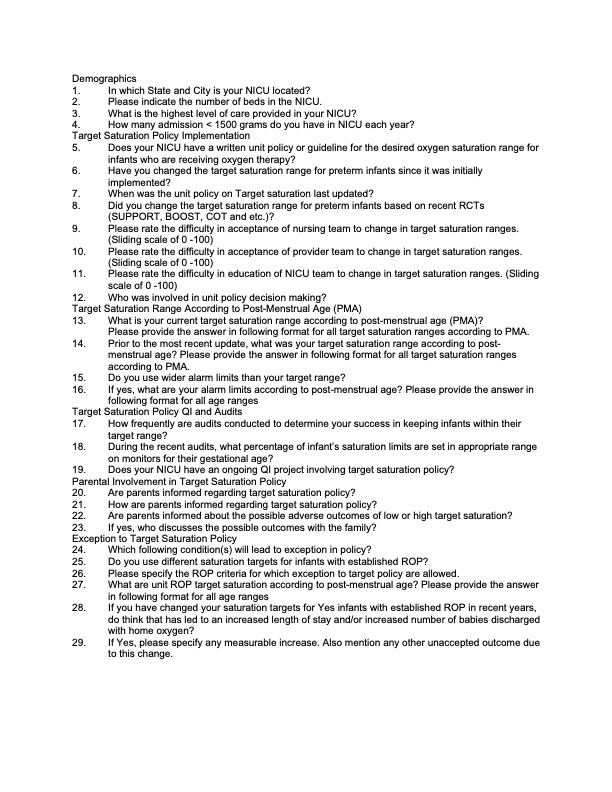Neonatal Pulmonology
Neonatal Pulmonology 5: NICU Practices
146 - Variability in Practice and Implementation of Target Saturation Policies in United States (US) Neonatal Intensive Care Units
Publication Number: 146.437
- pp
pratik parikh, MD
Assistant Professor
Baylor College of Medicine
San Antonio, Texas, United States
Presenting Author(s)
Background:
Oxygen is the most important therapy used in premature infants. Excess exposure may lead to retinopathy of prematurity whereas insufficient exposure may increase mortality. The use of supplemental oxygen is frequently targeted to specific ranges by setting upper and lower oxygen saturation alarm limits. There is a deficit in knowledge regarding contemporary oxygen saturation ranges in the United States.
Objective:
To describe typical target saturation ranges used for premature infants in the United States. To describe if these target saturation ranges have changed in recent years We developed a 29-question survey focused on target saturation practices and policies (Fig. 1). Between August and October of 2021, the survey was shared to the medical directors’ listserv for both Pediatrix Medical Group and the American Academy of Pediatrics Section of Neonatal-Perinatal Medicine and results collected via REDCap. Non-parametric tests and descriptive statistics were used for analysis. Responses were collected from 170 unique NICUs representing 36 states. The distribution of NICU size was < = 25 beds (72, 43%), 26-50 beds (51, 30%), 51-75 beds (28, 17%), 76-100 beds (11, 7%), and > 100 beds (7, 4%). A written policy for oxygen targeting in premature infants was frequent, but not universal (153, 92%), and most NICUs set alarm limits outside of their target saturation range (88, 54%). Most NICUs (130, 78%) have changed their standard saturation targets in response to recent clinical trials, with these changes largely occurring between 2018 and 2020 (77, 45%). Before the changes, the most commonly set lower saturation limits were 88%. After clinical trials, the lower set saturation limits were higher, with the most utilized 90% (Fig. 2a). Upper saturation limits also changed, with the most common set upper saturation limit increasing from 92% to 95% (Fig. 2b). Visualizing changing combined saturation limits (Fig. 3) reveals the most common saturation target range shifted from 88-92% to 90-95%. There are also inconsistencies in how NICUs set low and high alarm limits, in relation to the saturation targets. The greatest difference between set low alarm limit and low oxygen saturation limit was 10% with the highest difference between set high alarm limit and high saturation limit 5%. Over time, there has been a shift in practice towards using higher oxygen saturation targets within the United States, however no consensus exists in clinical practice. There exists a need to achieve consensus, to standardize care practices across sites and to optimize clinical outcomes.
Design/Methods:
Results:
Conclusion(s): 
.jpg)
.jpg)
